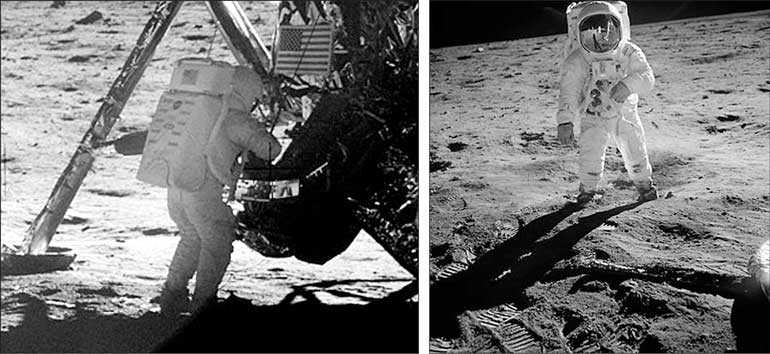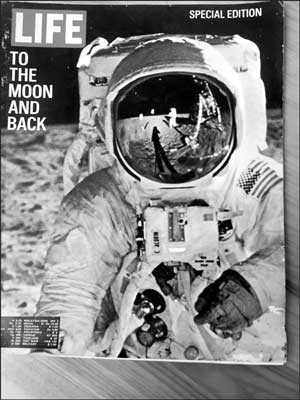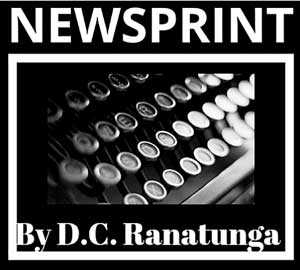Monday Mar 17, 2025
Monday Mar 17, 2025
Saturday, 20 July 2019 00:10 - - {{hitsCtrl.values.hits}}

 ‘Neil Armstrong’s booted foot, pressed firmly in the lunar soil, symbolised the stunning success of man’s highest adventure – the achievement, with the first moon step on the eve of 20 July 1969, the ambitious goal set by President John F. Kennedy eight year later’.
‘Neil Armstrong’s booted foot, pressed firmly in the lunar soil, symbolised the stunning success of man’s highest adventure – the achievement, with the first moon step on the eve of 20 July 1969, the ambitious goal set by President John F. Kennedy eight year later’.
This was the opening sentence of the special edition of LIFE, the most popular magazine of the day, on the historic feat when the first man set foot on the moon. (The magazine went out of print a few years back.)
It was a Saturday. Working on the Sunday Observer, Saturday afternoon was always busy. The first edition had to be ‘put to be bed’ fairly early to be dispatched to the outstations, particularly because the print order was bigger. So was the number of pages. Depending on the flow of the news a number of editions were printed.
Fifty years ago, in 1969, Saturday 20 July turned out to be an exciting, ‘extra busy’ day for us on the Observer editorial staff. It was the day history was created when a man set foot on the moon for the first time.
With no television at the time people got the news from the radio that evening and from the newspapers the following morning. Since they were keen to see pictures and read the news leisurely, newspapers were in demand.
Newspapers depended on Reuters, as the international news agency was referred to, to get foreign news. The newspapers registered with the Colombo office of Reuters to get the news. A ticker machine was set up for each newspaper to get the news when reams of paper continuously typed the news.
The sub-editor working on the foreign news page keeps an eye on the ticker to see whether anything interesting happens in the world. Though normally not much news of interest to us are noticed, that Saturday evening turned out to be a really busy one. The news that a man had stepped on the moon kept on coming continuously.
Editor Denzil Peiris was so excited that he kept a close eye on the news ticker, pulled out the copies, edited them himself and even took the copy down to the type-setting section of the printing department. Five editions of the Sunday Observer were printed that night and the readers in Colombo and suburbs were fortunate to get the latest edition.
Normally though the outstation copies of the Silumina are printed the previous night, a skeleton staff waited throughout Sunday to see whether there would be a need to do any adjustments to the news pages. Rarely was there a need to make any changes. That Saturday was different. The outstation readers would be waiting to read the moon landing story and see pictures.
To revert to LIFE, it used ‘To the moon and back’ as the caption of the cover picture with the sub-heading ‘A giant leap for mankind’ on the inner page. Along with colour photographs of mankind’s two-and-a-quarter walk on the moon LIFE carried detailed biographical portraits of Neil Armstrong, Edwin Aldrin and Michael Collins, and a report on the scientific experiments that were being conducted on the lunar samples they brought home.
The magazine also published a comprehensive illustrated history of manned space exploration from Yuri Gagarin’s first single orbit round the earth in 1961 until Armstrong’s adventure.

Discover Kapruka, the leading online shopping platform in Sri Lanka, where you can conveniently send Gifts and Flowers to your loved ones for any event including Valentine ’s Day. Explore a wide range of popular Shopping Categories on Kapruka, including Toys, Groceries, Electronics, Birthday Cakes, Fruits, Chocolates, Flower Bouquets, Clothing, Watches, Lingerie, Gift Sets and Jewellery. Also if you’re interested in selling with Kapruka, Partner Central by Kapruka is the best solution to start with. Moreover, through Kapruka Global Shop, you can also enjoy the convenience of purchasing products from renowned platforms like Amazon and eBay and have them delivered to Sri Lanka.
Discover Kapruka, the leading online shopping platform in Sri Lanka, where you can conveniently send Gifts and Flowers to your loved ones for any event including Valentine ’s Day. Explore a wide range of popular Shopping Categories on Kapruka, including Toys, Groceries, Electronics, Birthday Cakes, Fruits, Chocolates, Flower Bouquets, Clothing, Watches, Lingerie, Gift Sets and Jewellery. Also if you’re interested in selling with Kapruka, Partner Central by Kapruka is the best solution to start with. Moreover, through Kapruka Global Shop, you can also enjoy the convenience of purchasing products from renowned platforms like Amazon and eBay and have them delivered to Sri Lanka.